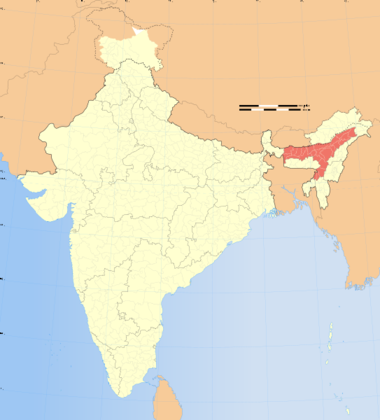Assam
Assamese অসম [Asom]
also, rarely, Assam Valley and formerly the Assam Province (British India), is a northeastern state of India and is one of the most culturally and geographically distinct regions of the country. Assam though one of the original provinces of British ruled Indian sub-continent and present day India having its legislature that dates back to 1937, the present day Assam; had undergone numerous territory alignment changes with its state map being altered highest number of times when compared to any other provincial level changes that has happened in Independent India. Known for exquisite natural resources, geography and its important role in India's freedom struggle; Assam has its capital as Dispur, an especialized city circuit region located on the outskirts of its largest metropolis, Guwahati. Located south of the eastern Himalayas, Assam comprises the Brahmaputra and the Barak river valleys along with the Karbi Anglong and the North Cachar Hills with an area of 30,285 square miles (78,440 km2). Assam is surrounded by six of the other Seven Sister States: Arunachal Pradesh, Nagaland, Manipur, Mizoram, Tripura and Meghalaya. These states are connected to the rest of India via a narrow strip in West Bengal called the Siliguri Corridor or "Chicken's Neck". Assam also shares international borders with Bhutan and Bangladesh; and cultures, peoples and climate with South-East Asia - important elements in India’s Look East policy. Assam became a part of India after the British occupied the region following the First Anglo-Burmese War of 1824–1826.
Known for Assam tea, large and old petroleum resources, Assam silk and for its rich biodiversity, Assam gets royalty from the government of India for its contribution to tea and other resources. However, the royalty contribution may not be in equal ratio with respect to production if compared against the recent price hikes in fuels and current market trends.
When comes to wildlife, Assam too has successfully conserved the one-horned Indian rhinoceros from near extinction, along with the tiger and numerous species of birds, and it provides one of the last wild habitats for the Asian elephant. It is becoming an increasingly popular destination for wildlife tourism, and Kaziranga and Manas are both World Heritage Sites.
Assam was also known for its Sal tree forests and forest products, much depleted now. A land of high rainfall, Assam is endowed with lush greenery and the mighty river Brahmaputra, whose tributaries and oxbow lakes provide the region with a unique hydro-geomorphic and aesthetic environment.
